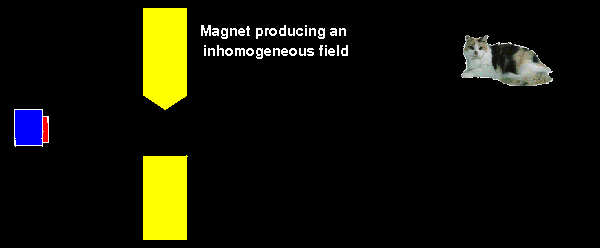 . On
the other hand, if the spin is pointing up (i.e. the spin state is
|+>) the particle will be pulled upwards, and will hit the poison
trigger, and the cat will end up in the state
. On
the other hand, if the spin is pointing up (i.e. the spin state is
|+>) the particle will be pulled upwards, and will hit the poison
trigger, and the cat will end up in the state
Imagine a modified Stern-Gerlach experiment, where instead of the
detectors for the particle, there is a cat sitting in the upper path
of the particle.
Imagine that there is some lethal poison kept next to the cat, and if
the particle hits it, the poison will be released and our pussy will conk
off. If the spin of the particle is |->, the particle will be pulled
downwards, and the state of the cat will remain what it was initially,
that is
 . On
the other hand, if the spin is pointing up (i.e. the spin state is
|+>) the particle will be pulled upwards, and will hit the poison
trigger, and the cat will end up in the state
. On
the other hand, if the spin is pointing up (i.e. the spin state is
|+>) the particle will be pulled upwards, and will hit the poison
trigger, and the cat will end up in the state
![]() .
.
Now if the particle has a spin state a|+> + b|->
to start with, when it passes through the inhomgeneous magnetic
field, it splits into a superposition of two wave-packets.
Only one part of the wave-packet reaches the cat-poison. This will
bring the poison in a superposition of having been released and not
having been released! Sounds weird? Read on.

This state of the poison will bring the cat into a
superposition of being dead and alive!! Only if one "looks at"
the other position where the lower part of the wave-packet should have
reached, one would be able to say if the particle has reached the
poison and killed the cat, or went the other way. If one detects the
particle in the lower region, one can be sure that our pussy is alive
and purring. On the other hand, if one finds that no particle reached
the lower region, one can be sure that our poor cat is no more. This is
exactly how quantum mechanics is supposed to work.
We never see real cats in such a state - so where is the catch?! The catch is in the assumption that the cat is completely isolated from its surrounding. Real cats are always intracting with the world around them, and not just with the mice! There is a small interaction with the ground on which the cat walks, with the air molecules around it, not to speak of numerous other large and small bodies around it. When a lot of these tiny intercations act together, they are enough to kill the superposition state, and drive the cat either to death, or to life. This phenomenon is known as decoherence. For an introduction to decoherence, see (W.H. Zurek, Physics Today, October 1991, pp. 36).